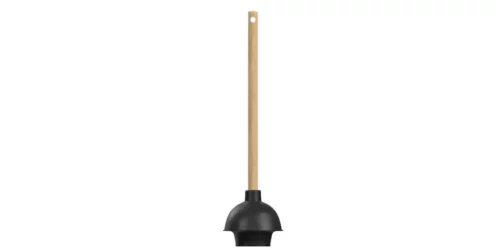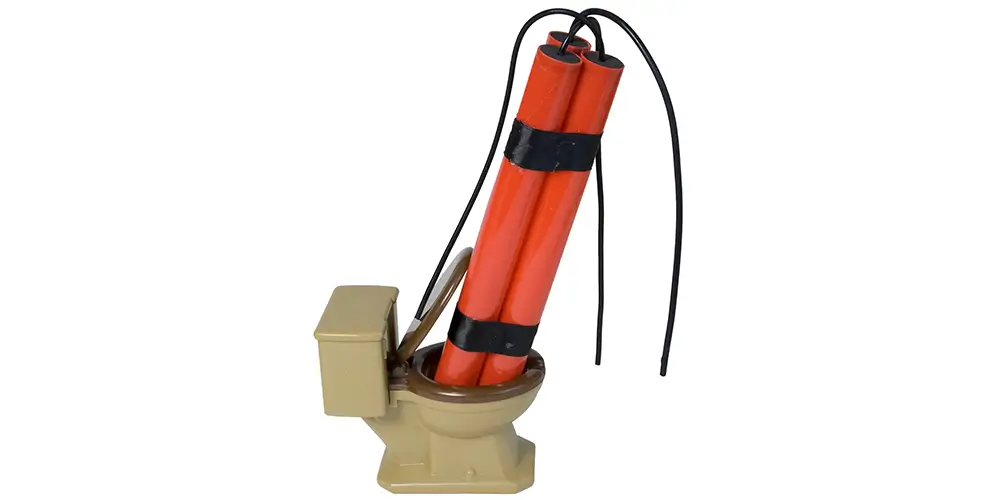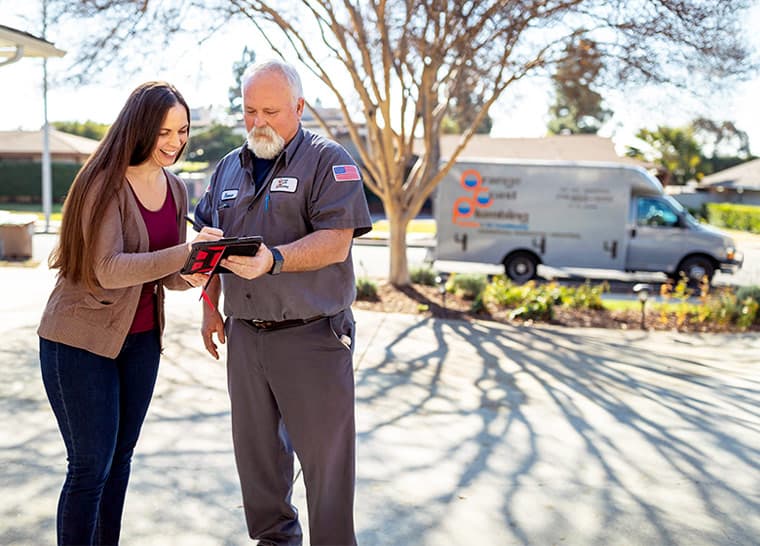Toilets clog for all kinds of reasons. Sometimes, they seem to clog out of spite.
It’s more likely that someone put too much paper in the bowl or that the sewer pipe is getting old and working at reduced capacity.
Most toilet clogs are minor and can be repaired DIY, but you need the right tools and knowledge for the job.
This blog will tell you what you need to know.
Are You Using the Right Plunger? Flange Plungers Are for Toilets
Yes, it makes a difference. Cup plungers, the most common in American households, don’t work for toilets! They’re designed for sink clogs.
So if you have a cup plunger from the Stone Age, by all means, keep it around. It has its uses — just not for the porcelain throne.
For toilet clogs, you’ll need a flange plunger with a “skirt” extending below the cup. The flange fits neatly into the toilet trap for a tight seal. And when it comes to plunging, it’s all about the seal and the suction the plunger produces.

Flange plunger for toilets
Do You Have an Airtight Seal?
You thought we were done with plungers. We’re not even close! Another thing to consider is the air trapped inside the cup of the plunger. You’ll want as little as possible because air compresses more readily than water.
Air reduces the suction of the plunger cup. Water doesn’t — at least not as much. And you thought you’d never use your high school physics.
If necessary, add a little water to the toilet bowl to operate the plunger efficiently. Don’t flush, though — unless you’re in the mood for mopping.
Plunging a Toilet Clog Like a Pro
- If the toilet bowl is empty, add just enough water to cover the plunger. Again, do NOT flush!
- Add dish detergent to the bowl to help with the seal.
- Force the plunger straight down into the toilet trap; position it to form a tight seal.
- Withdraw the plunger quickly. You’re pulling the clog toward you, not pushing it further in, where it can cause more trouble.
- Repeat the plunging process if necessary.
Plan B: A Toilet Auger for Stubborn Clogs
A snake can damage the porcelain of your toilet. A toilet auger is a better tool, expressly designed for toilet clogs, and less likely to scratch the porcelain.
A toilet auger effectively drills through the clog, hence its name. But it won’t work in every case. The clog may be too far down the line, or pipes may have corroded beyond DIY repairs.
How to Use a Toilet Auger
- Wear gloves; place a bucket beside the toilet for any waste you extract.
- Lift the toilet seat. Insert the auger into the toilet trap. The auger should have a rubber sheath at its neck to protect against scratching. It will reach no more than a few inches into the trap.
- Apply force to the auger until you feel resistance, meaning that your auger has come into contact with the clog.
- Crank the handle to drill into the clog.
- Remove the auger. It should dredge waste material from the clog. Offload that waste into the bucket.
- Pour water into the toilet bowl and let it drain. If it does, the clog has been removed. Victory is yours! But if no amount of auguring helps, it’s time to call the pros with their hydro jets.
When to Call for Help with a Clogged Toilet
Some toilet clogs are beyond the scope of DIY home repairs. If you’ve tried plunging and auguring and your toilet still won’t drain, it’s time for the plumbing cavalry.
The problem may be farther down the sewer line where only commercial-grade equipment can reach. The pros will also have video cameras to inspect the pipes further. They’ll show you exactly where the problem lies.
Don’t wait until a clog turns into a disaster! Call in reinforcements as soon as your DIY efforts fail or if there are other signs of bigger problems — like multiple drains backing up at once or foul odors emanating from them.
FAQs: Unclogging a Blocked Toilet
Q: Can I use a plunger for all types of clogs?
A flange plunger is effective for most toilet clogs, especially those caused by organic material.
Q: How do I properly use a plunger?
Place the plunger over the toilet’s drain hole to create a seal, and push down gently at first, followed by more vigorous plunging. The goal is to generate enough pressure to dislodge the clog.
Q: Is it safe to use chemical drain cleaners in toilets?
No, chemical drain cleaners can damage the plumbing. Stick to mechanical methods like plunging or using a toilet auger.
Q: What is a toilet auger, and how do I use it?
A toilet auger is a tool designed to snake through the toilet to break up or retrieve clogs. Insert the auger’s head into the toilet bowl and crank the handle to extend the cable until it reaches and clears the clog.
Q: Can hot water help unclog a toilet?
Adding a few cups of hot (but not boiling) water can dissolve some clogs, especially those involving greasy substances.
Q: To avoid clogs, what should I not flush down the toilet?
Avoid flushing items like wipes (even those labeled as “flushable”), sanitary products, cotton swabs, and excessive toilet paper.
Q: What are some home remedies for unclogging toilets?
Baking soda and vinegar can be effective for minor clogs. Pour 1 cup of baking soda and 2 cups of vinegar into the bowl, wait a few minutes, then flush with hot water.
Q: Can a clogged toilet eventually unclog itself?
In some cases, particularly if the clog is organic, it may break down over time and allow water to flow. However, this is unpredictable and could take considerable time. And how long can you wait before your next nature call?
Q: When should I call a professional plumber?
If you’ve attempted to clear the clog with a plunger or auger with no success or experiencing repeated clogs, it’s time for a professional plumber.
Q: How can I prevent toilet clogs?
Regular cleaning and maintenance, along with mindful flushing habits (only human waste and toilet paper), can significantly reduce the likelihood of clogs. Regularly inspecting the toilet’s flushing mechanism can also ensure it’s operating correctly.


